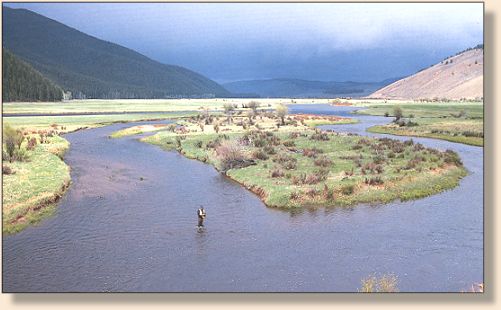
Big Hole History
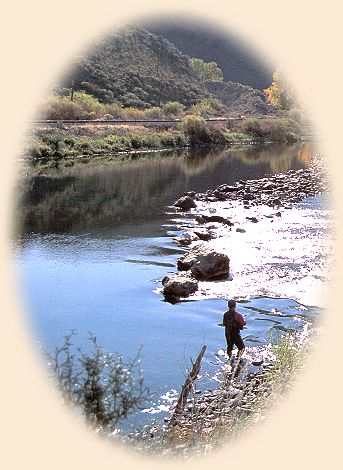 Settlers started arriving in the Big Hole Valley immediately after
the Nez Perce battle, [The Battle of the Big Hole, and the Trail
of Tears.] But before the settlers came, the Lewis and Clark
Expeditions passed through the valley in early August, 1805.
Having already named the Jefferson River after their President
and expedition sponsor, the party reach what Captain Lewis
described as the forks of the Jefferson. The explorers named
the forks for President Jefferson's three cardinal virtues - Philosophy,
Philanthropy, and Wisdom. The first river eventually went
back to its Indian name, Beaverhead. Philanthropy eventually
became known as Stinking Water, and is now the Ruby River.
The northerly fork which Lewis personally named Wisdom River is
now known as the Big Hole.
Settlers started arriving in the Big Hole Valley immediately after
the Nez Perce battle, [The Battle of the Big Hole, and the Trail
of Tears.] But before the settlers came, the Lewis and Clark
Expeditions passed through the valley in early August, 1805.
Having already named the Jefferson River after their President
and expedition sponsor, the party reach what Captain Lewis
described as the forks of the Jefferson. The explorers named
the forks for President Jefferson's three cardinal virtues - Philosophy,
Philanthropy, and Wisdom. The first river eventually went
back to its Indian name, Beaverhead. Philanthropy eventually
became known as Stinking Water, and is now the Ruby River.
The northerly fork which Lewis personally named Wisdom River is
now known as the Big Hole.
In the Journals of Lewis and Clark, they make
mention of the low water level of the Big Hole, and the difficulty
of navigation by boat. On Saturday, August 3rd, 1805, a passage
read, "The men were so much fortiegued today that they wished
much that navigation was at an end that they might go by land."
The Shoshone Indians knew the Big Hole Valley as Ground
Squirrel Valley, and the land of Big Snows. Lewis and Clark
called it Hot Springs Valley. Later it was to become known
as the Valley of 10,000 Haystacks. It was the trappers who
probably came up with the name "Big Hole" by describing
the valley it drains.
Angling has always been a draw to the Big Hole. Dewey Flats
was once a destination for fishermen from Butte, which was a
long day's ride by horseback. Today the Big Hole hosts visitors
from all over the country. The 'Hole,' as it is known by those
who frequent it, is a blue ribbon fishery, one of Montana's finest.
Fishing Through the Seasons
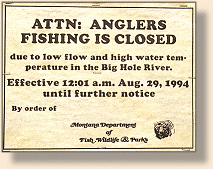 The Big Hole is a river in which fishing is very much influenced
by the seasons. Fluctuation in water flow, and consequently high
water temperatures, is the key reason the fishing drops off and
this can be attributed to a variety of reasons . . . Water flow
information is available from the USGS in Helena
(406) 449-5263. The gauging station is located between
Melrose and Glen, and when planning a float trip down
the Big Hole it is a good idea to call first . . . Records show
that the average flow of the Big Hole over a 64 year period
was 1,162 cfs.
The Big Hole is a river in which fishing is very much influenced
by the seasons. Fluctuation in water flow, and consequently high
water temperatures, is the key reason the fishing drops off and
this can be attributed to a variety of reasons . . . Water flow
information is available from the USGS in Helena
(406) 449-5263. The gauging station is located between
Melrose and Glen, and when planning a float trip down
the Big Hole it is a good idea to call first . . . Records show
that the average flow of the Big Hole over a 64 year period
was 1,162 cfs.
To put the minimum flow figure in perspective, when the Big
Hole was closed to fishing for a few months starting in August
of 1994, the flow was measured at the Melrose gauge around 130 cfs.
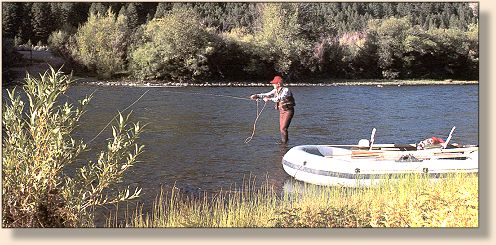
Spring:
Winters in the Big Hole Valley can be quite severe.
Temperatures are often brutal, dropping well below zero.
When the upper river begins to thaw in spring, good fishing
is not far off. In fact, you can fish much of the river whenever
there is open water.
During early spring the water level on the 'Hole' will normally be low.
Not like summertime lows, but low nonetheless. March will see a
slight rise in the river, but it isn't until April and May that there is
a significant increase in volume due to snow melt. Fishing during
this time can be interesting. The upper river and its tributaries are
good places to focus your attention, while there is ample water to
fish them. It is also a time when you see few anglers on the river.
Spring hatches on the Big Hole start, as in most western rivers,
with midges as soon as there is open water. If afternoons are
particularly warm, trout will rise to adults, even if there is still ice
around the edges of the stream. Wire pupas such as the Brassie
work well, as do many midge pupa imitations. For the adults on
top, its hard to beat the Griffith's Gnat tied in size 16 or 18.
[For the FLIES for the Big Hole click
here.]
 Hatches will be in full-swing by late April and May. The floating
angler should pay special attention to the banks, foam lines and
structure, making a point to anchor or get out and fish these areas
thoroughly. Caddis and mayfly hatches can produce top-water
feeding frenzies that trigger hot action to those who happen to be
on the water when its going on. Nearly any caddis pattern properly
presented this time of year in this stretch of river is a safe bet.
Hatches will be in full-swing by late April and May. The floating
angler should pay special attention to the banks, foam lines and
structure, making a point to anchor or get out and fish these areas
thoroughly. Caddis and mayfly hatches can produce top-water
feeding frenzies that trigger hot action to those who happen to be
on the water when its going on. Nearly any caddis pattern properly
presented this time of year in this stretch of river is a safe bet.
During a normal year, with normal snow-melt and runoff, the
salmonfly hatch will begin early to mid-June. Anglers descend
upon the Big Hole in masses to take part in the frenzy. This is
the busiest time of year on the 'Hole,' and the river can become
quite crowded with boats as well as bank anglers. Outfitters
from all over the state guide the Big Hole during the salmonfly
hatch, and, their presence, although legal, is quite the
controversy among local guides.
After the salmonfly hatch, fishing pressure on the 'Hole' drops
dramatically, even though angling is still very good . . . caddis
and mayfly hatches are abundant, and are pretty much
widespread throughout the entire river.
 Summer:
Summer:
June sees a major change in the flow of the river. Irrigation
demand is heavy and, with the watershed drying up by late
June like it has for the past several years, the flow of the 'Hole'
is greatly reduced, on average, from its peak of around 4,200
cfs at the first of the month, down to around 1,200 cfs by the
end of June. Early summer fishing is good though. Caddis
are the predominate hatch, with some smaller stoneflies and
again, a variety of mayflies.
It is wise to remember that there are some real monsters in this
river and the light tippets that produce 'the most' strikes will
most likely fail if you hook a true pig. It's a bit of a trade-off;
light tippet, dry fly - lot of fish or heavy tippet, big streamer - and
maybe a trophy. It's a tough call sometimes, especially when
you snap a large fish off that rose to your fly. What I like to do,
especially when floating, is to have two rods rigged, one with a
floating line and dry fly, the other with a big nymph or streamer.
That way I can fish the water more thoroughly and up my odds
of hooking Mr. Big.
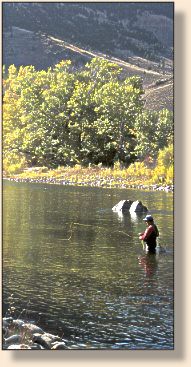 Fall:
Fall:
Traditionally, fall is my favorite time on the water. And the
Big Hole has been good to me in the fall. The period of time in
fall when night temperatures have cooled the water down enough
to make fish active again, all the way to ice-up can be a productive
time for monster hunting.
In fall, Baetis mayflies can be important during
hatches, which occur during the warmest part of the day. A tiny,
number 18 or 20 BWO or Black Baetis can take a surprising
number of fish if you find an area where a good hatch is coming
off. Watch along the banks close to good holding water. Trout
move to the edge of the faster current and sip in the small mayflies
right on the current seam. Takes are often very subtle, so keep a
close watch on your fly and leader.
You can find good Baetis beds along the entire
river system. I prefer to fish the canyon stretch near Divide when
the Baetis are on, and during the periods when
nothing is hatching, I will bounce a nymph along the bottom
through the deeper water with hopes it will find its way into the
mouth of a big brown.
As the water temperatures cool down below the 40 degree mark,
trout will be harder to make contact with and whitefish hookups
will be more frequent.
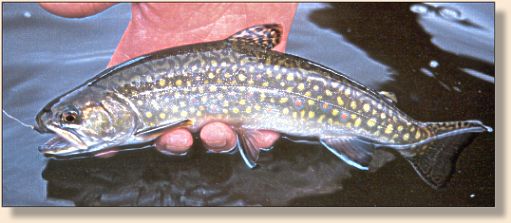
Winter:
At times trout can be taken during winter months but are
usually "incidental catches" by those fishing for whitefish. There
are some monster whitefish in the Big Hole, and they seem to be
very plentiful. There is an extended whitefish season on the Big
Hole from December 1 to the third Saturday in May with maggots
and/or artificial flies and lures only. Due to the abundance of these
fish, the limit is 100, [at this writing, always check local regulations.]
Although the winters can be cold and river ice can interfere with
fishing for whitefish, there are places on the stream where conditions
let you fish for whitefish for a good part of the winter season. Catches
by those targeting whitefish are usually high. [Whitefish are good
fighters, and are excellent table fare smoked.]
Tackle and Gear
 For most fishing on the Big Hole an eight to nine foot, four
or five-weight rod is a good choice. The exception would be
when fishing large streamers down deep for the large browns
which are found in the river. For this a six or seven-weight
system would be the wiser choice, keeping in mind that some
of the browns can exceed 10 pounds.
For most fishing on the Big Hole an eight to nine foot, four
or five-weight rod is a good choice. The exception would be
when fishing large streamers down deep for the large browns
which are found in the river. For this a six or seven-weight
system would be the wiser choice, keeping in mind that some
of the browns can exceed 10 pounds.
Even though western Montana has been caught in the grips of
an extended drought for several years now, expect extremes in
weather when visiting here, and come prepared. During summer
it can be dreadfully hot, but thunderstorms can rattle through with
little warning, so rain gear is important baggage on your float even
if you leave under clear blue skies. I know, I've been soaked more
than once while on this river! Spring and fall can host cold weather
whenever a front comes through. Keep in mind that the Big Hole
flows from over 7,000 feet down to an elevation of 4,600 feet.
Take a jacket along just in case!
The Big Hole is many things to many people. To me, it is one of
Montana's finest trout streams and that is why I keep going back.
But besides fishing, the area offers kayaking, hunting, rock-hounding,
gold panning, as well as rock climbing in the Humbug Spires.
Wildlife along the Big Hole is abundant, with large populations
of deer, elk and antelope. Black bears are common in the upper
valley, but there is no grizzly habitat. One of the largest winter
ranges for moose in Montana is between Wisdom and Ralston.
Of course, there are smaller animals along the river, beaver, mink,
and otter being the most interesting, as well as a myriad of birds,
including a variety of waterfowl. Rattlesnakes are common from
Divide downstream, so beware! ~ Steve Probasco
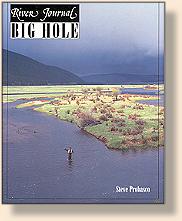 For a MAP of the Big Hole River, click
here.
For a MAP of the Big Hole River, click
here.
For the FLIES for the Big Hole River click
here.
To ORDER Big Hole River direct from the publisher, click
HERE.
Credits: From the Big Hole River, part of the River
Journal series, published by Frank Amato Publications.
We greatly appreciate use permission.
|

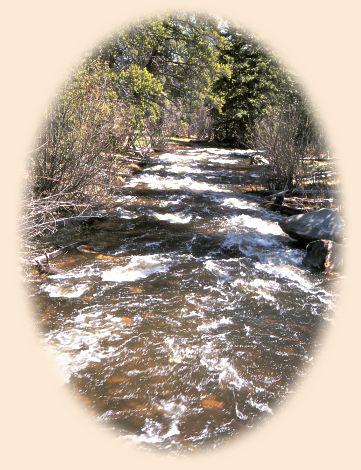


 Settlers started arriving in the Big Hole Valley immediately after
the Nez Perce battle, [The Battle of the Big Hole, and the Trail
of Tears.] But before the settlers came, the Lewis and Clark
Expeditions passed through the valley in early August, 1805.
Having already named the Jefferson River after their President
and expedition sponsor, the party reach what Captain Lewis
described as the forks of the Jefferson. The explorers named
the forks for President Jefferson's three cardinal virtues - Philosophy,
Philanthropy, and Wisdom. The first river eventually went
back to its Indian name, Beaverhead. Philanthropy eventually
became known as Stinking Water, and is now the Ruby River.
The northerly fork which Lewis personally named Wisdom River is
now known as the Big Hole.
Settlers started arriving in the Big Hole Valley immediately after
the Nez Perce battle, [The Battle of the Big Hole, and the Trail
of Tears.] But before the settlers came, the Lewis and Clark
Expeditions passed through the valley in early August, 1805.
Having already named the Jefferson River after their President
and expedition sponsor, the party reach what Captain Lewis
described as the forks of the Jefferson. The explorers named
the forks for President Jefferson's three cardinal virtues - Philosophy,
Philanthropy, and Wisdom. The first river eventually went
back to its Indian name, Beaverhead. Philanthropy eventually
became known as Stinking Water, and is now the Ruby River.
The northerly fork which Lewis personally named Wisdom River is
now known as the Big Hole.



 Hatches will be in full-swing by late April and May. The floating
angler should pay special attention to the banks, foam lines and
structure, making a point to anchor or get out and fish these areas
thoroughly. Caddis and mayfly hatches can produce top-water
feeding frenzies that trigger hot action to those who happen to be
on the water when its going on. Nearly any caddis pattern properly
presented this time of year in this stretch of river is a safe bet.
Hatches will be in full-swing by late April and May. The floating
angler should pay special attention to the banks, foam lines and
structure, making a point to anchor or get out and fish these areas
thoroughly. Caddis and mayfly hatches can produce top-water
feeding frenzies that trigger hot action to those who happen to be
on the water when its going on. Nearly any caddis pattern properly
presented this time of year in this stretch of river is a safe bet. Summer:
Summer: Fall:
Fall: For a MAP of the Big Hole River, click
For a MAP of the Big Hole River, click